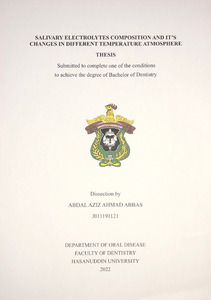Abbas, Abdulaziz Ahmad (2023) SALIVARY ELECTROLYTES COMPOSITION AND IT’S CHANGES IN DIFFERENT TEMPERATURE ATMOSPHERE. Skripsi thesis, Universitas Hasanuddin.
![[thumbnail of J011191121_skripsi_01-02-2023 cover1.png]](/41522/5.hassmallThumbnailVersion/J011191121_skripsi_01-02-2023%20cover1.png)

J011191121_skripsi_01-02-2023 cover1.png
Download (1MB) | Preview
J011191121_skripsi_01-02-2023 1-2.pdf
Download (2MB)
J011191121_skripsi_01-02-2023 dp.pdf
Download (2MB)
J011191121_skripsi_01-02-2023.pdf
Restricted to Repository staff only
Download (2MB)
Abstract (Abstrak)
Saliva is composed of a variety of electrolytes, including sodium, potassium, calcium, magnesium, bicarbonate, and phosphates. Also found in saliva are immunoglobulins, proteins, enzymes, mucins, and nitrogenous products, such as urea and ammonia. These components interact in related function in the following general areas: (1) bicarbonates, phosphates, and urea act to modulate pH and the buffering capacity of saliva; (2) macromolecule proteins and mucins serve to cleanse, aggregate, and/or attach oral microorganisms and contribute to dental plaque metabolism; (3) calcium, phosphate, and proteins work together as an antisolubility factor and modulate demineralization and remineralization; and (4) immunoglobulins, proteins, and enzymes provide antibacterial action., The normal pH of saliva is 6 to 7, meaning that it is slightly acidic. The pH in salivary flow can range from 5.3 (low flow) to 7.8 (peak flow).
Saliva is a unique fluid that contributed to the development of a new diagnostic tool in the past few years. The research has shown that a wide spectrum of hormones, nucleic acids, electrolytes, and proteins/peptides can be related to multiple local and systemic diseases. It is said that saliva reflects the “body’s health” and wellbeing, but until recently its use as a diagnostic tool has been hindered because the examination of the biomolecules that exist in saliva and their relevance and association with different etiologies has been not enough explored. Used for the diagnosis of systemic diseases, saliva is an important advantage, primarily because saliva contains a small amount of plasma. Plasma derived biomarkers in saliva facilitate the continuous monitoring of the oral and general health status.
| Item Type: | Thesis (Skripsi) |
|---|---|
| Subjects: | R Medicine > RK Dentistry |
| Divisions (Program Studi): | Fakultas Pendidikan Dokter Gigi > Pendidikan Dokter Gigi |
| Depositing User: | Nasyir Nompo |
| Date Deposited: | 14 Jan 2025 01:29 |
| Last Modified: | 14 Jan 2025 01:29 |
| URI: | http://repository.unhas.ac.id:443/id/eprint/41522 |


